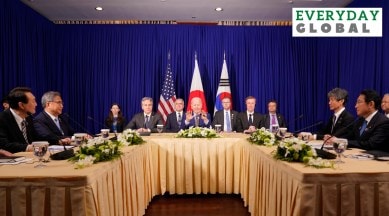Everyday Explained: What is ASEAN, the 10-member grouping of Southeast Asian nations?
Prime Minister Narendra Modi has said ASEAN is central to India’s Act East policy, which focuses on the extended neighbourhood in the Asia-Pacific region.

The annual summit of the Association of South East Asian Nations (ASEAN) under the chairmanship of Cambodia was held from November 10 to November 13. Amid the war in Ukraine and contestation between US and China, the 10-member regional grouping stressed its common interest and concern, such as strengthening energy cooperation and people-to-people connectivity.
Indonesia’s president Joko Widodo mentioned the idea of a new Cold War amid increasing tensions between the United States and China, saying ASEAN would not become “a proxy to any powers”.
What is ASEAN?
As its website states, On 8 August 1967, five leaders – the Foreign Ministers of Indonesia, Malaysia, the Philippines, Singapore and Thailand – came together in Bangkok. Thailand was brokering some disputes among Malaysia, Indonesia and the Philippines, and it eventually led to the signing of a document.
“The five Foreign Ministers who signed it – Adam Malik of Indonesia, Narciso R. Ramos of the Philippines, Tun Abdul Razak of Malaysia, S. Rajaratnam of Singapore, and Thanat Khoman of Thailand – would subsequently be hailed as the Founding Fathers of probably the most successful inter-governmental organization in the developing world today. And the document that they signed would be known as the ASEAN Declaration.”
Over the next few decades, five other countries joined them – Brunei Darussalam, Lao PDR, Cambodia, Myanmar and Vietnam. They have an anthem, a flag and biannual summits (twice a year) with a rotating chairmanship. An example of the focus on unity, its official motto is “One Vision, One Identity, One Community”.
The ASEAN Declaration signed by the five leaders conveyed the aspiration to further regional cooperation. These were about cooperation in the economic, social, cultural, technical, educational and other fields, and in the promotion of regional peace and stability and adherence to the principles of the United Nations Charter. It stipulated that the Association would be open for participation by all States in the Southeast Asian region subscribing to its aims, principles and purposes.
Its major pillars that helps lay out a blueprint for cooperation are Political-Security Community (APSC), Economic Community (AEC) and Socio-Cultural Community (ASCC).
What is India’s link with ASEAN?
Apart from the individual ties that India has had with these countries, Prime Minister Narendra Modi has said ASEAN is central to India’s Act East policy, which focuses on the extended neighbourhood in the Asia-Pacific region. The policy was originally conceived as an economic initiative but has gained political, strategic and cultural dimensions including the establishment of institutional mechanisms for dialogue and cooperation. In 2018, ASEAN leaders were the chief guests at India’s republic day parade.
India is part of the ASEAN Plus Six grouping, which includes China, Japan, South Korea, New Zealand and Australia as well.
In 2010 a Free Trade Agreement was also signed and entered into force between India and ASEAN. While India was part of negotiations to join the Regional Comprehensive Economic Partnership (RCEP) in 2020, it ultimately decided not to do so. However, in the largest seven years trade has grown in terms of value, barring the pandemic years of 2020 and 2021.
ASEAN itself has recently faced issues that complicate coordination, such as the rise of China and its claims over the South China Sea (many of which compete with claims of ASEAN members like the Philippines) and the issue of military conflict in Myanmar.